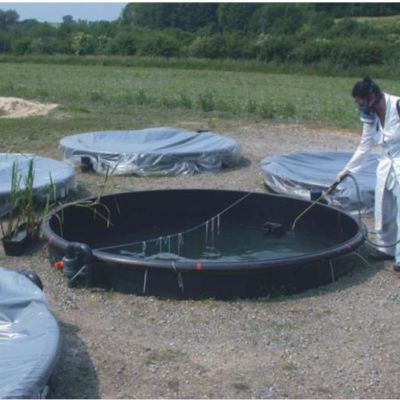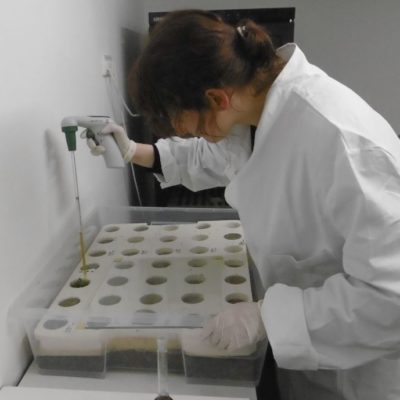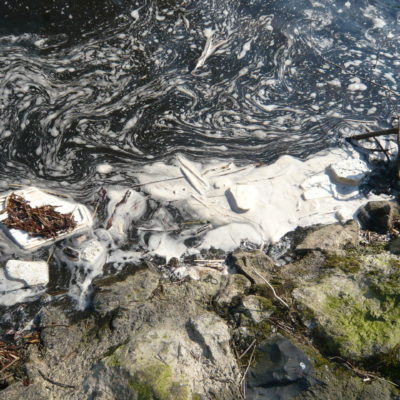2021
Toschki, A., Daniels, B., Oellers, J., Rumohr, Q., Schäffer, A., Sybertz, A., Roß-Nickoll, M. (2021): Integriertes Monitoring in der Agrarlandschaft - Erfassung der ökologischen Auswirkungen des chemischen Pflanzenschutzes, FKZ 3717644120. Umweltbundesamtes, TEXTE 136/2021, Dessau-Roßlau. ISSN 1862-4804.
Publication2020
Toschki, A., Hammers-Wirtz, M., Hommen, U., Klein, M., Poßberg, C., Römbke, J., Roß-Nickoll, M., Schäffer, A., Scheffczyk, A., Schmidt, B., Scholz-Starke, B. (2020): Evaluation of the risk for soil organisms under real conditions: Development of a national position for amending downstream legislations of the new EU Plant Protection Products Regulation; Final Report, Project No. (FKZ) 3710 67 410, Report No. EF001129-ENG. Umweltbundesamt, TEXTE 201/2020: 302 pp. + Appendix. ISSN: 1862-4804.
Publication2020
van Gestel, C. A. M., Mommer, L., Montanarella, L., Pieper, S., Coulson, M., Toschki, A., Rutgers, M., Focks, Römbke, J. (2020): Soil biodiversity: state-of-the art and possible implementation in chemical risk assessment. Integrated Environmental Assessment and Management. doi: 10.1002/ieam.4371.
Publication2019
Hammers-Wirtz, M., Classen, S., Deermann, L., Strauss, T. (2019): NANO-Transfer – Transfer kohlenstoffbasierter Nanomaterialien in der aquatischen Umwelt: Verbleib, Effekte, Bioakkumulation, Nahrungsnetzübertragung, Schadstofftransport und Einsatz in der Remediation belasteter Gewässer. Teilprojekt Forschungsinstitut gaiac – Mesokosmosstudie. Abschlussbericht. BMBF-Projekt gefördert im Rahmen von ERA-Net SIINN. FKZ 03XP0061C.
2019
Jia, Y., Chen, Q., Crawford, S. E., Song, L., Chen, W., Hammers-Wirtz, M., Strauss, T., Seiler, T.-B., Schäffer, A., Hollert, H. (2019): Cyanobacterial blooms act as sink and source of endocrine disruptors in the third largest freshwater lake in China. Environmental Pollution 245: 408-418. DOI: 10.1016/j.envpol.2018.11.021.
Publication2018
Gergs, A., Classen, S., Ladermann, K., Strauss, T., Hammers-Wirtz, M. (2018): The STREAMcom model – Simulating chemical effects on stream macroinvertebrate communities. Poster presentation, SETAC Europe 13th Special Science Symposium, 23-24 October 2018, Brussels, Belgium.
Poster2018
Hammers-Wirtz, M., Oellers, J., Fürste, A., Miller, S., Peeters, S., Willius, N., Toschki, A. (2018): Nanomobil: Synthetische Silber-Nanopartikel im System Boden-Grundwasser - Mobilität, Wirkungen auf die Lebensgemeinschaft und Wechselwirkung zwischen Hydro-, Pedo- und Biosphäre. Teilprojekt D: Biosphäre. Abschlussbericht, BMBF-Projekt, FKZ 03X0151D.
2018
Gergs, A., Classen, S., Palmqvist, A., Rakel, K., Strauss, T., Zuleger, W., Hammers-Wirtz, M. (2018): Modelling approaches for a scenario based assessment of chemically induced impacts on aquatic macroinvertebrate communities (MACROMOD). Final Report. Project LRI-ECO28 funded by CEFIC – The European Chemical Industry Council.
2018
Toschki, A., Hammers-Wirtz, M., Scholz-Starke, B, Roß-Nickoll, M. (2018): Assessment of pesticides on a landscape level - What is basically needed? Platform presentation, SETAC Europe 28th Annual Meeting, 13-17 May 2018, Rome, Italy.
Presentation2018
Brückner, I., Klaer, K., Schiwy, S., Kirchner, K., Hammers-Wirtz, M., Müller, Y., Shuliakevich, A., Classen, S., Stepkes, H., Grunau, T., Dolny, R., Gebhardt, W., Gschwendtner, R., Montag, D., Könemann, S., Wendt, L., Hollert, H., Agler-Rosenbaum, M., Reichert, J., Pinnekamp, J. (2018): Abschlussbericht der Phase 1 des Forschungsvorhabens Demonstrationsvorhaben Ozonung des Abwassers auf der Kläranlage Aachen-Soers (DemO3AC). Gerichtet an das MULNV NRW. Düren, 2018.
2018
Hammers-Wirtz, M., Strauss, T., Toschki, A. (2018): Added value of community approaches in environmental risk assessment. Poster presentation, SETAC Europe 28th Annual Meeting, 13-17 May 2018, Rome, Italy.
Poster2018
Strauss, T., Classen, S., Knautz, T., Hammers-Wirtz, M. (2018): Investigating the Trojan horse effect of nanoparticles on an aquatic community – An outdoor mesocosm study. Poster presentation, SETAC Europe 28th Annual Meeting, 13-17 May 2018, Rome, Italy.
Poster2017
Toschki, A., Oellers, J., Willius, N., Hammers-Wirtz, M. (2017): A new screening approach for testing natural soil communities in the laboratory. Poster presentation, SETAC Europe 27th Annual Meeting, 07-11 May 2017, Brussels, Belgium.
Poster2017
Hammers-Wirtz, M., Oellers, J., Fürste, A., Miller, S., Peeters, S., Willius, N., Toschki, A. (2017): Investigating effects of silver nanoparticles on the soil community – An outdoor TME study. Poster presentation, SETAC Europe 27th Annual Meeting, 07-11 May 2017, Brussels, Belgium.
Poster2016
Gergs, A., Classen, S., Strauss, T., Ottermanns, R., Brock, T. C. M., Ratte, H. T., Hommen, U., Preuss, T. G. (2016): Ecological recovery potential of freshwater organisms: Consequences for environmental risk assessment of chemicals. Reviews of Environmental Contamination and Toxicology 236: 259-294. DOI: 10.1007/978-3-319-20013-2_5.
Publication2014
Kubiak, R., Hommen, U., Bach, M., Classen, S., Gergs, A., Golla, B., Guerniche, D., Klein, M., Krumpe, J., Preuss, T. G., Ratte, H. T., Roß-Nickoll, M., Schäfers, C., Strauss, T., Toschki, A., Trapp, M. (2014): Georeferenced probabilistic risk assessment of pesticides – Further advances in assessing the risk to aquatic ecosystems by spray drift from permanent crops. UBA TEXTE 05/2014: 477pp., Umweltbundesamt, Dessau-Roßlau, Germany. ISSN: 1862-4804.






